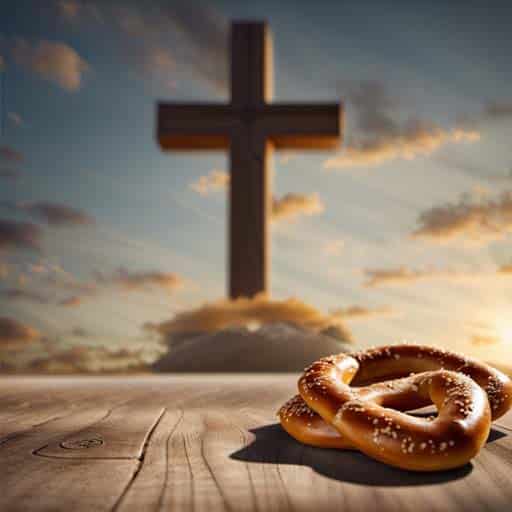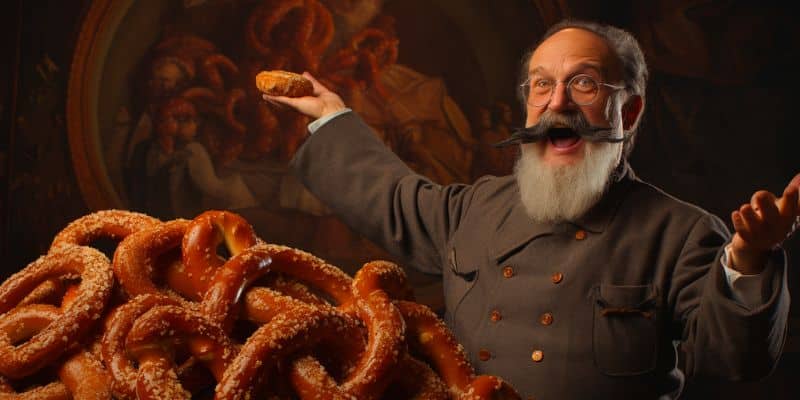Pretzels have an interesting history. Monks created them centuries ago. It was a sign of spirituality and good luck. The first reference is from 1111. They rewarded children for praying during Lent. Over time they spread across Europe. They reached America with German immigrants in the 19th century.
The shape of the pretzel symbolizes arms crossed in prayer. It’s still associated with religious festivals and celebrations.
In the 17th century, bakers boiled the dough before baking it. This created the soft pretzel we know today. Pennsylvania is the “birthplace” of American pretzel production. German settlers brought their recipes and techniques there. Reading, Pennsylvania is known as Pretzel City USA. It’s still a hub for production and consumption in the US.
The pretzel has a rich heritage. Next time you eat one, remember it and savour every bite!
Origins of the pretzel
To understand the origins of the pretzel, delve into its early mentions in history and explore the intriguing connection between pretzels and religion.
Early mentions of pretzels in history
The table below gives a timeline and reveals that pretzels originated in monasteries during the 6th century in Europe. By the 13th century, a recipe for them was recorded in Germany. Then, in 16th century Austria, a Pretzel Bakers Guild was established.
Pretzels gained fame fast and spread across Europe. They became symbols of luck and prosperity. The Bakers Guild took great pride in their craftsmanship, passing down secret recipes through generations.
Over time, different regions added unique twists to the original recipe. Now, pretzels are a worldwide snack. From soft bread versions to crunchy snacks with numerous flavors, there’s something for every taste.
Don’t miss out! Explore centuries-old traditions by tasting pretzels from different cultures. Enjoy the delightful treats and connect with history.
The connection between pretzels and religion
Pretzels have an unexpected religious connection. It dates back centuries to Catholic monks in medieval times. These monks shaped the dough to form pretzels, crossing the ends to look like arms in prayer.
They gave these to children as a reward for learning their prayers.
The three holes of the pretzel represent the Holy Trinity – the Father, Son, and Holy Spirit. This adds a deeper meaning to these snacks.

During Lent, when meat is abstained from, pretzels are a popular food choice. Their ingredients – flour, water, and salt – make them permissible. This strengthens their connection to religious observance.
Next time you eat a pretzel, appreciate its history and symbolism. It’s a reminder that even everyday foods can have deeper meanings connected to our beliefs and traditions.
Evolution of the pretzel
To understand the evolution of the pretzel, delve into its fascinating history. Explore the spread of pretzels in Europe and their journey to America. Uncover the unique stories and cultural significance behind these beloved baked treats.
Spread of pretzels in Europe
The pretzel – a beloved snack with an impressive history – has been enjoyed across Europe for centuries. We can trace its origin to Germany. Let’s explore how it became a popular treat in different European countries!
Spread of pretzels in Europe:
| Country | Year | Notable Fact |
|---|---|---|
| Germany | 610 AD | The birthplace of the pretzel, where it was first created by monks. |
| Austria | 1200s | Viennese pretzel recipe emerged, giving Austria a unique twist. |
| France | 1400s | French bakers started incorporating pretzels into their pastries and breads. |
| Switzerland | 1500s | Pretzels were seen as symbols of luck, often used during marriage ceremonies. |
| Italy | 1600s | Pretzels started being made with local ingredients like olive oil and rosemary. |
| Netherlands | 1700s | Dutch immigrants introduced pretzels to America. |
Pretzels kept travelling through Europe. In Belgium, variants like chocolate-covered and sweet dough versions became popular. Tapas recipes in Spain included pretzels. Scandinavia used them during festive occasions. Pretzels not only influenced regional cuisines, but also became part of cultural traditions and celebrations.
Now, an interesting anecdote – Marie Antoinette, during the French revolution, is famous for saying “Let them eat cake”. But, less known is her love for pretzels! So strong was her fondness for these twisted treats, she secretly ordered special deliveries of pretzels to her chambers in the palace. This highlights the powerful allure of pretzels and how they can captivate royalty.
The evolution and spread of pretzels across Europe have left an everlasting mark on the culinary landscape. From Germany’s monastic beginnings to Marie Antoinette’s clandestine indulgence, the history and appeal of these twisted delights still fascinate food lovers across the continent.
Pretzels in America
Pretzels are deeply rooted in America. Records show that German immigrants brought them over to Pennsylvania in the 18th century. Quickly, they became a favorite across the nation.
Interesting facts about pretzel brands:
- Brand: Snyders
- Year Established: 1909
- Notable Innovations: Introduction of pretzel sticks

- Brand: Auntie Anne’s
- Year Established: 1988
- Notable Innovations: Pretzel stands in shopping malls

- Brand: Auntie Anne’s
- Year Established: 1921
- Notable Innovations: Production of flavored pretzels

Pretzels have changed over time. They have gone from the traditional twisted knot to other forms, like sticks, rods, and bites. This allows for different snacking experiences.
For an even better experience, pair your pretzel with a dip like mustard, cheese, or chocolate ganache.
Pretzels are an integral part of American culture. So go ahead and enjoy this iconic treat!
Famous pretzel recipes and variations
To explore famous pretzel recipes and variations, dive into the fascinating world of soft pretzels and Bavarian pretzels. Discover the unique flavors and techniques behind these delectable treats. Uncover the secrets to making perfectly soft pretzels, or savor the traditional goodness of Bavarian-style pretzels. Indulge your taste buds with these enticing pretzel variations.
Soft pretzels
Soft pretzels have been around since the Middle Ages in Germany, and they’ve gained popularity in America. Nowadays, they come in many varied forms, like cinnamon sugar-topped or even dipped in chocolate for a sweeter twist.
Soft pretzels are incredibly versatile. They can be enjoyed plain or with dips like mustard or cheese sauce. Plus, they make great bases for sandwiches or sliders.
Did you know that the largest pretzel ever created was 842 pounds? Amazingly, it was made by the Harvest Preparatory School in Ohio in 2013. It must’ve been one delicious pretzel – everyone must’ve been craving more!
Bavarian pretzels
Bavarian pretzels are iconic – they’ve got a distinctive twisted shape, like crossed arms! Hand-rolling the dough into strips, then crossing them over, creates this shape. And a dip in boiling water and a high-temp bake gives them their crunchy exterior. Coarse salt is sprinkled on before baking to give them a savory flavor. Inside, they’re soft and chewy thanks to simple ingredients like flour, water, yeast, and salt.
Creative variations of this treat are also popular. Additions like sesame or poppy seeds provide extra flavor, while fillings like cheese or ham make savory twists. For an authentic experience, try it fresh from the oven – the contrast between crunchy and soft is delightful! Enjoy with a cold beer or warm coffee. Bavarian pretzels are a must-try for any pretzel fan!
Cultural significance of pretzels
To understand the cultural significance of pretzels and their impact on society, delve into the sub-sections of “Pretzels in traditions and celebrations” and “Pretzels in popular culture”.
Pretzels in traditions and celebrations
Pretzels have a special place in many cultural traditions and celebrations. They are treasured for their shape and flavor. Let’s find out more about the role of pretzels in different customs!
Pretzels in Traditions & Celebrations:
Pretzels have an important cultural significance. People use them in weddings, religious ceremonies, and other special occasions. Here is a look at how they are used in different cultures:
| Tradition/Celebration | Country | Meaning/Importance |
|---|---|---|
| Oktoberfest | Germany | Symbolizes good luck and prosperity |
| Hanukkah | Jewish Community | Represents intertwined arms of loved ones |
| Weddings | United States | Brings good fortune to newlyweds |
| Carnival | Brazil | Symbolizes unity during parades |
Pretzels have so much more than their taste. They carry symbolic meanings that bring people together.
Plus, pretzels vary depending on the region. Some places prefer sweet flavors like cinnamon sugar or icing, while others stick to the classic savory taste. This variety shows us how cultures differ.
Next time you eat a pretzel, take a moment to appreciate its history. Join in on this age-old tradition that binds people together. Enjoy the joy and significance of using pretzels in your traditions and celebrations. Add a touch of charm to your gatherings with pretzels!
Conclusion and final thoughts 💭
The pretzel has made a lasting impression throughout history. Its roots can be traced back to ancient times, where it was considered a symbol of luck and wealth. From Rome to medieval Europe, the pretzel has changed and adapted. Its shape and flavor have been cherished for centuries.
The connection between pretzels and religious customs has been hardly looked at. In medieval times, the three holes of the pretzel were thought to symbolize the Holy Trinity, making it common at Christian festivities. It was even given as a sign of love or used in ceremonies, giving it a deeper meaning.
Pretzels also come in various flavors and styles across different cultures. From the soft and chewy New York-style pretzel to the crisp and twisted Bavarian version, there is something for everyone. Each area adds its own touch to this classic snack, using ingredients like salt, sesame seeds, or cinnamon sugar to make variations that appeal to different tastes.
Frequently Asked Questions
What is the origin of pretzels?
The exact origin of pretzels is disputed, but they are believed to have been created by European monks in the early Middle Ages, possibly as early as the 6th century AD.
Why are pretzels associated with Germany?
Pretzels have a strong association with Germany because of their popularity in Bavaria. German immigrants later introduced pretzels to America, and they have remained a staple snack in German communities.
How did pretzels become popular in America?
Pretzels gained popularity in America thanks to the large influx of German immigrants in the 18th and 19th centuries. The soft pretzel, often sold by street vendors in cities like New York and Philadelphia, became especially popular.
What is the significance of the pretzel’s shape?
The pretzel’s distinctive shape has various symbolic interpretations. It has been associated with religious symbolism, resembling arms crossed in prayer. It was also used to represent good luck, as the twisted shape was believed to bring prosperity.
How did pretzels evolve over time?
Pretzels have evolved over time, with different variations emerging. Hard pretzels were developed in the late Middle Ages as a way to preserve bread by removing the moisture. Nowadays, various flavors and shapes are available, including pretzel sticks, rods, and nuggets.
Are pretzels still a popular snack today?
Absolutely! Pretzels are still a beloved snack worldwide and can be found in many forms, from traditional soft pretzels to pretzel buns, pretzel snacks, and even chocolate-covered pretzels. Their delicious taste and versatility ensure their continued popularity.





Leave a Reply